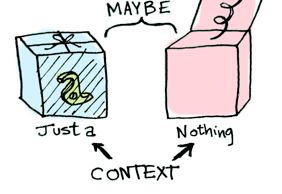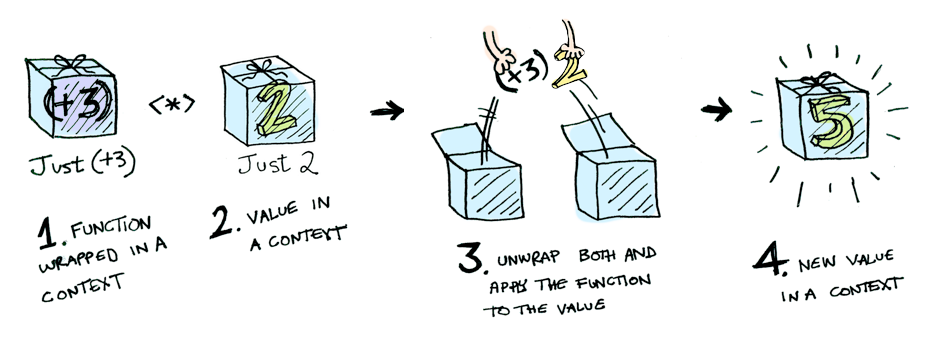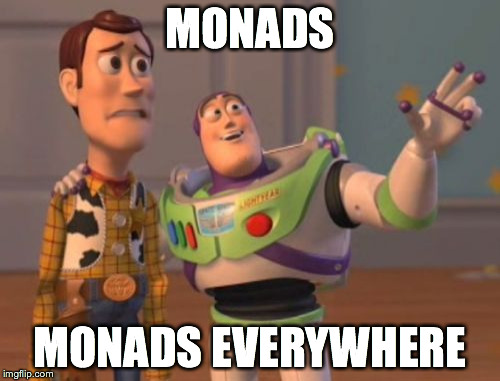https://github.com/orakaro/swift-monad-maybe-reader-and-try
Proof of concept: Maybe, Reader and Try monad
https://github.com/orakaro/swift-monad-maybe-reader-and-try
functor monads reader-monad swift
Last synced: 6 months ago
JSON representation
Proof of concept: Maybe, Reader and Try monad
- Host: GitHub
- URL: https://github.com/orakaro/swift-monad-maybe-reader-and-try
- Owner: orakaro
- License: mit
- Created: 2016-07-15T01:19:44.000Z (about 9 years ago)
- Default Branch: master
- Last Pushed: 2020-03-08T07:11:20.000Z (over 5 years ago)
- Last Synced: 2025-03-26T11:51:08.030Z (7 months ago)
- Topics: functor, monads, reader-monad, swift
- Language: Swift
- Homepage:
- Size: 14.6 KB
- Stars: 166
- Watchers: 7
- Forks: 6
- Open Issues: 1
-
Metadata Files:
- Readme: README.md
- License: LICENSE
Awesome Lists containing this project
README
# Preface
This post has many awesome pictures which credits go to [Aditya Bhargava](https://twitter.com/_egonschiele). His original article
[Functors, Applicatives, And Monads In Pictures](http://adit.io/posts/2013-04-17-functors,_applicatives,_and_monads_in_pictures.html) is extremely well written, with sample code in Haskell though.
In this post I will try to provide proof of concept of Functor/Applicatives/Monad in pure Swift, plus example for using Reader Monad for Dependency Injection(DI), and the idea of Try monad concept from Scala.
# Maybe is Functor
We all know the Optional Type (the ? mark) in Swift. We can define our option type named `Maybe` using enum.
```swift
enum Maybe {
case Just(T)
case Nothing
}
```
Simple enough! A `Maybe` type is a "box" which can contains the value or ... nothing

The interesting part come from here: we can define a `fmap` function which takes a normal function and a `Maybe` type, then return another `Maybe`

How does `fmap` look like? Well, its implement is not that hard
```swift
extension Maybe {
func fmap(f: T -> U) -> Maybe {
switch self {
case .Just(let x): return .Just(f(x))
case .Nothing: return .Nothing
}
}
}
```
And the "magic" above is actually not-so-magical. At this time, our `Maybe` type is already a **Functor**.

# Maybe is Applicatives
Applicatives is a type which can define the function `apply` that
* Take a function wrapped in that type
* Take also a value wrapped in that type
* Then return a new value which is wrapped also

I will define an `apply` function for `Maybe`
```swift
extension Maybe {
func apply(f: Maybe U>) -> Maybe {
switch f {
case .Just(let JustF): return self.fmap(JustF)
case .Nothing: return .Nothing
}
}
}
```
That is it! Our `Maybe` now is both **Functor** and **Applicatives**.
# Maybe is Monad
> How to learn about Monads:
>
> 1. Get a PhD in computer science.
> 2. Throw it away because you don’t need it for this section
`Maybe` can be considered as a monad if it can define a function `flatmap` that
* Take a function *which return type is* `Maybe`
* Take also a value wrapped in `Maybe`
* Return another `Maybe`
Let's Swift! Here is our `flatMap` and bind operator `>>=`
```swift
extension Maybe {
func flatMap(f: T -> Maybe) -> Maybe {
switch self {
case .Just(let x): return (f(x))
case .Nothing: return .Nothing
}
}
}
infix operator >>= { associativity left }
func >>=(a: Maybe, f: T -> Maybe) -> Maybe {
return a.flatMap(f)
}
```
Suppose that we already have a `half` function that return an `Maybe` type
```swift
func half(a: Int) -> Maybe {
return a % 2 == 0 ? Maybe.Just(a / 2) : Maybe.Nothing
}
```
Then with the `>>=` operator you can chain `Maybe` like:
```swift
Maybe.Just(20) >>= half >>= half >>= half
```
And this is how it is actually processed

Now our `Maybe` is **Functor**, **Applicatives** and also **Monad** as well.
# A step further, the Reader monad
In this section I will introduce minimal version for one of three useful Monads: the Reader Monad
```swift
class Reader {
let g: E -> A
init(g: E -> A) {
self.g = g
}
func apply(e: E) -> A {
return g(e)
}
func map(f: A -> B) -> Reader {
return Reader{ e in f(self.g(e)) }
}
func flatMap(f: A -> Reader) -> Reader {
return Reader{ e in f(self.g(e)).g(e) }
}
}
```

As you can see, we have `map`, and `flatMap` function here. This class type is both **Functor** and **Monad** at the same time. Very same with `Maybe` monad above, `Reader` can define infix operator and chain to whenever we want.
```swift
infix operator >>= { associativity left }
func >>=(a: Reader, f: A -> Reader) -> Reader {
return a.flatMap(f)
}
func half(i: Float ) -> Reader {
return Reader{_ in i/2}
}
let f = Reader{i in i} >>= half >>= half >>= half
f.apply(20) // 2.5
```
## Why Reader monad matter
Reader monad take `g` function in `init` time. By switching (or *injecting*) this function, we can create our own Dependency Injection(DI) framework easily. Let's see an example:
This is our model:
```swift
struct User {
var name: String
var age: Int
}
struct DB {
var path: String
func findUser(userName: String) -> User {
// DB Select operation
return User(name: userName, age: 29)
}
func updateUser(u: User) -> Void {
// DB Update operation
print(u.name + " in: " + path)
}
}
```
and usage:
```swift
let dbPath = "path_to_db"
func update(userName: String, newName: String) -> Void {
let db = DB(path: dbPath)
var user = db.findUser(userName)
user.name = newName
db.updateUser(user)
}
update("dummy_id", newName: "Thor")
// Thor in: path_to_db
```
In real life `DB` may be compicated and seperated as a whole infrastructure layer. Assume that `DB` can find an user by his name and update his information to the Database.
The problem is `update` function now holding a reference to `dbPath`, which I want to switch during test or runtime. I will rewrite the `update` function to return only a `Reader`
```swift
struct Environment {
var path: String
}
func updateF(userName: String, newName: String) -> Reader {
return Reader{ env in
let db = DB(path: env.path)
var user = db.findUser(userName)
user.name = newName
db.updateUser(user)
}
}
```
then call `Reader.apply` later base on what passed through Environment variable.
```swift
let test = Environment(path: "path_to_sqlite")
let production = Environment(path: "path_to_realm")
updateF("dummy_id", newName: "Thor").apply(test)
// Thor in: path_to_sqlite
updateF("dummy_id", newName: "Thor").apply(production)
// Thor in: path_to_realm
```

# The Try Monad
Scala's `Try` type is a functional approach for error handling. Very likely to Optional (or `Maybe`), `Try` is a "box" that contains value or a *Throwable* if something has gone wrong. `Try` can be a Successful or a Failure.
```swift
enum Try {
case Successful(T)
case Failure(ErrorType)
init(f: () throws -> T) {
do {
self = .Successful(try f())
} catch {
self = .Failure(error)
}
}
}
```
To make `Try` a functor/monad, I will add `map` and `flatMap` function
```swift
extension Try {
func map(f: T -> U) -> Try {
switch self {
case .Successful(let value): return .Successful(f(value))
case .Failure(let error): return .Failure(error)
}
}
func flatMap(f: T -> Try) -> Try {
switch self {
case .Successful(let value): return f(value)
case .Failure(let error): return .Failure(error)
}
}
}
```
With an operation which can throws some ErrorType, just wrap them inside a Try and chain(with `map` and `flatMap`) to whenever you want. At every step the result will be a `Try` type. When you want the real value inside that box, just do a pattern matching.
```swift
enum DoomsdayComing: ErrorType {
case Boom
case Bang
}
let endOfTheWorld = Try {
throw DoomsdayComing.Bang
}
let result = Try {4/2}.flatMap { _ in endOfTheWorld}
switch result {
case .Successful(let value): print(value)
case .Failure(let error): print(error)
}
// Bang
```
# Conclusion
1. A functor is a type that implements map.
2. An applicative is a type that implements apply.
3. A monad is a type that implements flatMap.

* `Maybe` have map, apply and flatMap, so it is a functor, an applicative, and a monad.
* `Reader` is a monad which can be used for DI(Dependency Injection)
* `Try` is a monad, and so as `Future`, `Signal` or `Observable` (see their `flatMap` implement!)

Thanks for reading this article and feel free to give any feedback or suggestion. You can open a pull request or reach me out at [@dtvd88](https://twitter.com/dtvd88). If you want to play around with above class, clone this repo and open the Playground.
Many thanks to [Aditya Bhargava](https://twitter.com/_egonschiele) for his awesome blog.